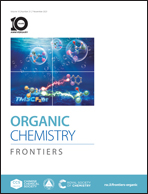NBN embedded phenalenes as a new class of zigzag type polycyclic aromatic hydrocarbons for explosive detection†
Abstract
Nitrogen–boron–nitrogen (NBN) unit modified polycyclic aromatic hydrocarbons (PAHs) have garnered significant attention due to their captivating electronic and optoelectronic properties. Herein, we present a succinct palladium-catalyzed cyclization strategy, yielding a diverse array of NBN-phenalenes. The inherent structural diversity of these compounds offers a promising avenue to probe into their intricate structure–property correlations. Notably, thorough scrutiny involving ultraviolet–visible and fluorescence spectra and density functional theory (DFT) calculations reveals the tunable nature of their geometric and electronic structures, as well as their photophysical characteristics. Remarkably, the NBN-fused ring system has been effectively harnessed for the detection of nitro explosives, proving its high sensitivity and ability to detect trinitrotoluene (TNT) at the ppm level. Test strips were used to identify TNT visually. Potential uses for this quick and accurate TNT detection technique include enhancing public safety This research offers a strategic approach to construct nitrogen–boron–nitrogen fused ring structures, exploring their luminescence properties and forging innovative capabilities.



 Please wait while we load your content...
Please wait while we load your content...